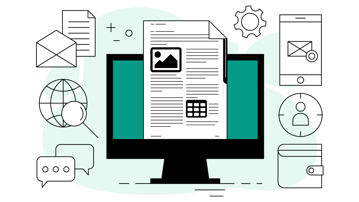Have you ever wondered if all your proposals were as strong as they could be? Did they really answer the customer's questions and showcase your solution in the best light? Did they highlight your expertise and know-how? While a great proposal doesn’t always guarantee a win, a poorly crafted one can almost certainly lead to a loss.
We’re here to help! Below are 6 simple steps to improve your proposal process and create submissions that evaluators will want to read—and award.
Content Library
Working on a complex, high-priority proposal means collaborating with many contributors, and managing numerous cross-team tasks. Finding the right content elements at the right time and ensuring accuracy can be frustrating.
To streamline this process, start by creating standard answers to common questions and unstructured frameworks to guide more unique requirement content. With assets like these, your team quickly finds, leverages, and tweaks up-to-date content, ensuring consistency across your proposal. Everyone saves time to address those unique requirements of each bid. Work smarter, not harder!
Layout
You put a lot of effort into your proposal, so don’t undermine it with a confusing layout! Tables without titles, a missing table of contents, sloppy design, long blocks of text without bullet points or graphics, and inconsistent margins all send a bad message: "Your project isn't important enough for us to craft a proposal you’d want to read and support."
Even if these issues are last-minute oversights or mistakes, evaluators won’t care—they won’t waste time trying to understand a poorly designed proposal. They’ll skim through it and quickly move on to the next bid.
Eliminate those formatting mistakes by setting up a pre-defined layout template according to your brand guidelines and proposal specifications. Automating this process eliminates reformatting and prevents last-minute errors. You’ll save time and produce a polished, easy-to-read proposal that evaluators want to engage with. A quality layout leads to a quality proposal, making it easier for evaluators to read and ultimately consider your bid.
Collaboration
Creating a proposal is a collaborative process. Each contributor must manage their tasks while staying in sync with the overall process. However, real-time collaboration among multiple contributors is nearly impossible using a traditional document editing tool. Silos and email leave individual contributors out of the loop and out of sync with rest of the team.
By using a collaborative database, proposal writing as a team is far more efficient. Multiple contributors write and review simultaneously on the same document. They share information and expertise, and provide feedback and guidance, that accelerates the process and produces higher quality without so many revisions.
Suggested content



Know Your Customer
Does your proposal serve your business needs more than those of your customer? Your proposal should be about them, not you. It should highlight the impact your solution will have on their business, not just promote your product or service.
A strong proposal is focused on the customer's needs from beginning to end. The key is to understand your customers' problems and tailor your proposal to their specific needs. What are their needs and requirements? Their challenges and goals? What are their fears and potential objections?
Craft your argument by showing how your solution will help them meet their goals. Clearly explain the value and benefits of your offer, emphasizing how it aligns with their goals and objectives.
needs and requirements? What challenges are they facing? What do they hope to achieve?
Be Clear and Concise
Clarity is key when writing a winning proposal! Demonstrate how your offer stands out by presenting relevant information aligned with your customer’s needs and requests. Use clear, concise language to explain how your solution addresses their requirements, and don’t hesitate to use illustrations or diagrams to clarify your points.
Remember, evaluators have to review many proposals. Lengthy paragraphs, long-winded sentences, and unclear messaging are the last things they want to deal with. Make it easy for them by:
- Crafting short, straightforward sentences.
- Avoiding jargon and overly technical terms.
- Organizing your arguments logically.
- Following an approved format.
Review Content
Ready to hit "send"? Hold on. Have you and your team thoroughly proofread the proposal to avoid errors and inaccuracies? Your proposal reflects the importance you place on your customer's project and the quality of work they can expect from your company. Even small typos leave a bad impression. So does outdated or conflicting information. This is where evaluators might lose patience and quickly turn to a competitor’s bid.
Streamline your proposal process with a solution that offers an integrated workflow to save time. This will help keep your team on track, giving you more time to focus on final reviews that improve overall quality.
The key to creating the perfect proposal is to continually improve the process that produces your content. Focus on short-term gains while building a long-term strategy. Adopting a document solution with a centralized database for your proposals will boost both efficiency and quality, helping you land that winning bid.








